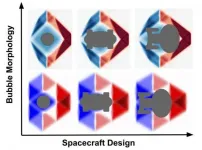(Press-News.org) LA JOLLA, CA--Translational research led by scientists at La Jolla Institute for Immunology (LJI) has resulted in a promising combination therapeutic candidate for adults with recent-onset type 1 diabetes.
The combination therapy was recently tested in a randomised, double-blind, placebo-
controlled, phase 2 trial run and funded by pharmaceutical company Novo Nordisk. The results, published recently in The Lancet Diabetes and Endocrinology, point to a potential way to treat the autoimmune disease without leaving the body vulnerable to infectious disease.
The therapeutic candidate combines anti-IL-21 antibody with the diabetes drug liraglutide. This two-pronged approach is based on research findings from the lab of LJI Professor Matthias von Herrath, M.D., who also serves as vice president and senior medical officer, Global Chief Medical Office, at Novo Nordisk.
"This is the first large trial for a combination therapy, and the data suggest it has value for patients," says von Herrath. "The groundwork for choosing a combination therapy was laid through preclinical work at La Jolla Institute."
Type 1 diabetes is an autoimmune disease that occurs when the body's own T cells mistakenly target insulin-producing beta cells in the pancreas. When beta cells die, the body loses its ability to regulate glucose levels, which can eventually lead to severe organ damage and death.
One challenge in treating type 1 diabetes is that therapies targeting "system-wide" T cell responses also run the risk of hindering the immune system's ability to fight real threats, such as viruses and bacteria.
The von Herrath Laboratory at LJI is focused on uncovering the molecular triggers of type 1 diabetes. Their work has pointed to ways to modulate parts of the immune system without suppressing overall immune system function.
In 2012, the von Herrath Laboratory published a study in Immunity showing the importance of the interleukin (IL)-21 receptor in allowing harmful T cells into the pancreas. Follow-up studies showed that an anti-IL-21 antibody could interrupt that signal and potentially shield the pancreas from attack.
Importantly, because the anti-IL-21 antibody appears to only affect a group of T cells, von Herrath and his colleagues believed the antibody might help treat type 1 diabetes without dampening the overall immune system.
In 2017, Novo Nordisk published a pre-clinical study in the Journal of Autoimmunity showing the effects of a combination therapy that consisted of anti-IL-21 monoclonal antibody combined with the FDA-approved type 2 diabetes drug liraglutide. Liraglutide has been shown to protect beta cell function. The study, which included von Herrath as a co-author, showed that this combination could reverse type 1 diabetes in a mouse model.
For the new study, von Herrath and his collaborators tested the combination therapy in a randomized, parallel-group, placebo-controlled, double-dummy, double-blind, phase 2 trial. Compared with the placebo group, patients who received the 54-week course of treatment had higher levels of endogenous insulin secretion. No safety concerns were identified.
The researchers followed up with study participants for 26 weeks after the treatment ended and found that the effects diminished during that time. They also found no lasting adverse changes to the immune system. The researchers note that the combination therapy will need to be assessed for long-term safety and efficacy in a phase 3 clinical trial.
Going forward, von Herrath and his laboratory at LJI are focused on translating their findings on both type 1 diabetes and type 2 diabetes from the laboratory to the clinic.
INFORMATION:
The study, "Anti-interleukin-21 antibody and liraglutide for the preservation of β-cell function in adults with recent-onset type 1 diabetes: a randomised, double-blind, placebo-controlled, phase 2 trial," was funded entirely by Novo Nordisk.
DOI: https://doi.org/10.1016/S2213-8587(21)00019-X
About La Jolla Institute for Immunology
The La Jolla Institute for Immunology is dedicated to understanding the intricacies and power of the immune system so that we may apply that knowledge to promote human health and prevent a wide range of diseases. Since its founding in 1988 as an independent, nonprofit research organization, the Institute has made numerous advances leading toward its goal: life without disease.
COLUMBIA, Mo. - In the midst of a pandemic that has claimed more than 2 million lives worldwide and disrupted nearly every facet of society since it appeared more than a year ago, understanding the factors that create and facilitate disease outbreaks is more important than ever. Now, researchers at the University of Missouri have determined that cognitive biases -- patterns of errors in thinking that affect judgments and behaviors, often unconsciously -- can help create and worsen foodborne disease outbreaks.
"Unethical behavior isn't always intentional; conflicts of interest and other unconscious motivations can lead people to behave ...
WHAT:
Approximately two years after establishing a human cerebral organoid system to study Creutzfeldt-Jakob disease (CJD), National Institutes of Health researchers have further developed the model to screen drugs for potential CJD treatment. The scientists, from NIH's National Institute of Allergy and Infectious Diseases (NIAID), describe their work in Scientific Reports.
Human cerebral organoids are small balls of human brain cells ranging in size from a poppy seed to a pea; scientists use human skin cells to create them. CJD, a fatal neurodegenerative brain disease of humans caused by infectious prion proteins, affects about 1 in 1 million people each year. It can arise spontaneously, result from ...
Philadelphia, March 9, 2021 - Schizophrenia is a neurodevelopmental disorder that disrupts brain activity producing hallucinations, delusions, and other cognitive disturbances. Researchers have long searched for genetic influences in the disease, but genetic mutations have been identified in only a small fraction--fewer than a quarter--of sequenced patients. A new study now shows that "somatic" gene mutations in brain cells could account for some of the disease neuropathology.
The study, led by senior author Jeong Ho Lee, MD, PhD, at Korea Advanced Institute of Science and Technology and the team of Stanley Medical Research Institute, appears in Biological ...
According to the current BfR-Corona-Monitor of the German Federal Institute for Risk Assessment (BfR), 43 percent of the respondents have already had themselves tested for the virus. The survey, which has been conducted regularly for almost a year now, documents how the population is dealing with the situation, what they are doing to protect themselves and how they are informing themselves about the current events. "For 50 weeks now, our survey has provided insights into the current situation and its development," says BfR-President Professor Dr. Dr. Andreas Hensel. "Over time, we see that the vast majority of the population is implementing the key protective measures."
BfR-Corona-Monitor as to 2-3 March 2021:
https://www.bfr.bund.de/cm/349/210302-bfr-corona-monitor-en.pdf
Regarding ...
PLYMOUTH MEETING, PA [March 9, 2021] -- New research in the March 2021 issue of JNCCN--Journal of the National Comprehensive Cancer Network from Mass General Hospital Cancer Center, Harvard Medical School, and Dana-Farber Cancer Institute finds muscle mass (quantity) correlated with survival, while muscle radiodensity (quality) was associated with symptom burden, healthcare use, and survival in patients with advanced cancer undergoing an unplanned hospitalization. The researchers also found nearly two-thirds of the patients in that population had significant muscle loss ...
BUFFALO, N.Y. -- New research from the University at Buffalo suggests that breast cancer patients who drink sugar-sweetened beverages regularly are at increased risk for death from any cause and breast cancer in particular.
Compared to women who never or rarely drank non-diet soda, those who reported drinking non-diet soda five times or more per week had a 62% higher likelihood of dying from any causes, and were 85% more likely to die from breast cancer specifically. The findings were published online ahead of print March 2 in Cancer Epidemiology, Biomarkers & Prevention, a journal of the American Association for Cancer Research.
Research on soda and breast ...
Researchers at Uppsala University have developed a digital self-test that trains users to assess news items, images and videos presented on social media. The self-test has also been evaluated in a scientific study, which confirmed the researchers' hypothesis that the tool genuinely improved the students' ability to apply critical thinking to digital sources.
The new tool and the scientific review of it are part of the News Evaluator project to investigate new methods of enhancing young people's capacity for critical awareness of digital sources, a key component of digital literacy.
"As ...
Philadelphia, March 9, 2021--Combining computational mining of big data with experimental testing in the lab, researchers at Children's Hospital of Philadelphia (CHOP) have identified RNA editing events that influence gene expression and, in turn, the phenotypic manifestation of that expression. In analyzing so-called A-to-I RNA editing, in which the adenosine of an RNA molecule is chemically modified into an inosine, the researchers describe how a single nucleotide change by RNA editing can have large downstream effects. The findings were published today in Genome Biology.
"Millions of A-to-I RNA editing sites have been identified across the human transcriptome, but the functions of most RNA editing ...
If travel to distant stars within an individual's lifetime is going to be possible, a means of faster-than-light propulsion will have to be found. To date, even recent research about superluminal (faster-than-light) transport based on Einstein's theory of general relativity would require vast amounts of hypothetical particles and states of matter that have "exotic" physical properties such as negative energy density. This type of matter either cannot currently be found or cannot be manufactured in viable quantities. In contrast, new research carried out at the University of Göttingen gets around this problem by constructing a new class of hyper-fast 'solitons' ...
Researchers have demonstrated that a slimy, yet tough, type of biofilm that certain bacteria make for protection and to help them move around can also be used to separate water and oil. The material may be useful for applications such as cleaning contaminated waters.
In the journal Langmuir, North Carolina State University researchers reported the findings of an experiment in which they used a material produced by the bacteria Gluconacetobacter hansenii as a filter to separate water from an oil mixture.
"It's really remarkable to think that these little bugs can make this stuff that is so perfect in many ways," said Lucian Lucia, the study's corresponding author and an associate professor of forest biomaterials and chemistry at NC State.
The biofilm the bacteria make and ...






